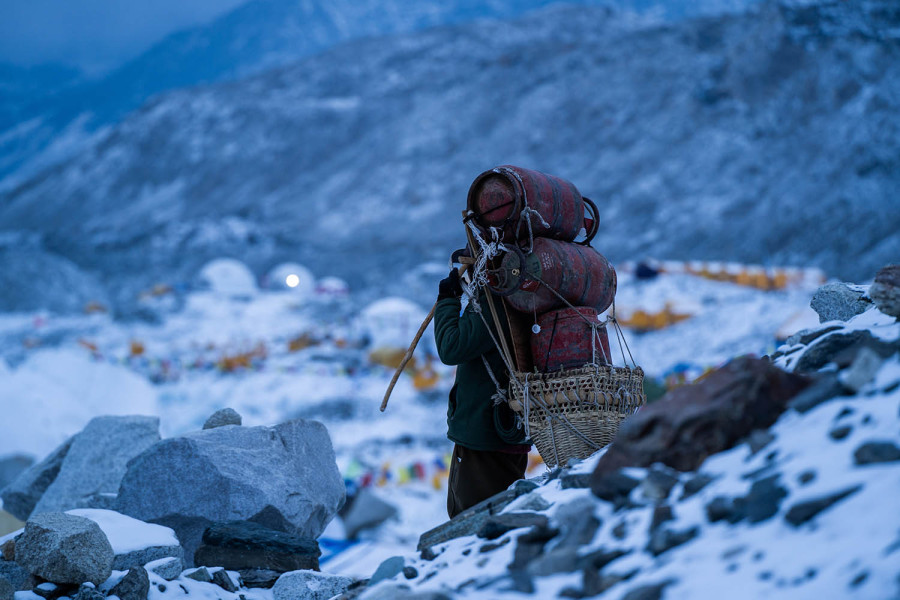Money
Electric or LPG stoves: Why is Nepal desperate to build a gas pipeline?
Last week, Nepal’s industry minister visited Delhi to discuss a cross-border LPG pipeline.
Krishana Prasain
Nepal appears desperate to build a multi-million dollar cross-border liquefied petroleum gas (LPG) pipeline project and has started serious homework for the same.
However, there is a paradox in the policy.
Nepal is also preparing a 12-year plan to boost energy production and expand the market. The target is to produce over 28,000MW of electricity by 2035.
Electric stoves are considered safer than LPG stoves as they do not have an open flame or combustible fuel source.
The clear winner, however, will be LPG, as, according to experts, politicians have been lobbying for the gas pipeline without proper homework on the future of hydro and its investment.
Nepal's petroleum import bill stood at Rs337.34 billion in the last fiscal, of which Rs55.61 billion was spent on cooking gas.
Last week, Industry Minister Damodar Bhandari visited New Delhi, India, where a discussion was held on building a cross-border gas pipeline with Hardeep S Puri, India’s Minister for Petroleum and Natural Gas.
The ministers agreed ‘in principle’ to move forward with the project.
Nepal has already chosen a site in Sarlahi, and the pipeline will come there from Motihari, India.
“Once the project’s estimated cost is finalised, the two governments will decide on the funding modality,” said Baburam Adhikari, joint secretary of the Ministry of Industry, Commerce and Supplies.
Nepal had requested the Indian government to build the LPG pipeline on grant. However, insiders say, as in the case of petroleum supply, Nepal should sign a long-term LPG supply agreement with India to make the project viable.
If the government pushes for the LPG pipeline, what will be the future of hydropower, and what will happen to the government plan to use hydroelectricity in households?
“That’s is not a good idea,” said Ganesh Karki, president of the Independent Power Producers’ Association, Nepal. The government should instead focus on increasing the country's power production and its domestic consumption, he said.
Experts say reducing LPG imports by around Rs50 billion will help narrow the ballooning trade deficit.
“We should not be dependent on LPG from India. We need to reduce its imports by prioritising electricity consumption,” said Karki.
“Such LPG pipeline projects will take Nepal nowhere. We are spending billions to import LPG, which will obviously impact Nepal’s hydropower development,” said Karki. “If we promote fossil fuels and LPG imports, why would investors inject funds into hydro development?”
The industry ministry and Nepal Oil Corporation officials say India is positive about supporting the construction of the Motihari-Sarlahi LPG project.
Nepal buys all of its cooking gas from India, supplied by gas bullets.
Nepal has been approaching India for the LPG pipeline construction since 2015 when the southern neighbour imposed a trade blockade.
The India blockade, which began on September 23, 2015, and lasted about six months, was an economic and humanitarian crisis that severely affected Nepal and its economy.
The cross-border LPG and oil pipelines were envisaged when Nepal suffered from an acute power shortage.
In January 2015, the then Commerce Minister Sunil Bahadur Thapa and then Oil Minister Dharmendra Pradhan of India agreed to send an Indian technical team to Nepal to study the feasibility of setting up LPG and natural gas pipeline infrastructure from India to Nepal.
Construction on the project began in April 2018 and was completed in April 2020.
Now, with a hydro energy surplus, Nepal no longer needs an LPG pipeline, warn hydro investors.
Observers say the LPG pipeline project could make Nepal more dependent on fossil fuels. In the coming years, the country will have abundant renewable energy to power the transport sector as well as energy-efficient electric stoves in its kitchens.
An energy expert working on a government project, who wished not to be named, told the Post in August that building an LPG pipeline is another blunder. “Nepal will soon see a considerable amount of electricity generation that could substitute cooking gas and reduce trade deficit.”
Environmentalists, too, have been saying that Nepal’s private sector is aggressively investing in hydropower, and the government’s investment in petroleum infrastructure could be a setback for them and the country.
The government also has a goal of installing 500,000 improved cooking stoves, primarily in rural areas, and an additional 200,000 household biogas plants and 500 large-scale biogas plants.
Nepal’s strategy is to have electric stoves as the primary cooking method in 25 percent of households by 2030.
To meet this target, Nepal would need to invest $25 billion, according to estimates.
According to Nepal’s National Statistics Office, among the 6.66 million households in the country, 51 percent use firewood and 44.3 percent use LPG in their kitchens.
Among other types of cooking fuels, 0.5 percent of the families use electricity, 2.9 percent use dung cakes, 1.2 percent use biogas and 0.1 percent use kerosene or other fuels.
Bagmati province, which contains Kathmandu Valley and has 1.56 million households, leads in LPG consumption, with 69.8 percent of the families using it for cooking.
Besides the proposed LPG pipeline, in August, Nepal and India agreed on projects for an oil pipeline connecting Siliguri of India to Charali in Jhapa, a greenfield tank terminal in Charali, and on an extension of the pipeline from Amlekhgunj to Lothar in Chitwan.




 9.88°C Kathmandu
9.88°C Kathmandu














